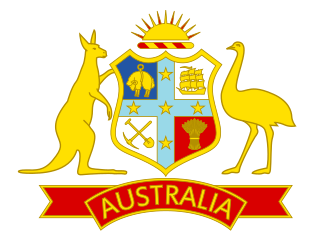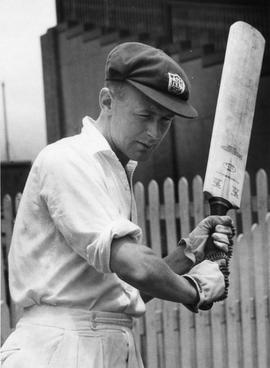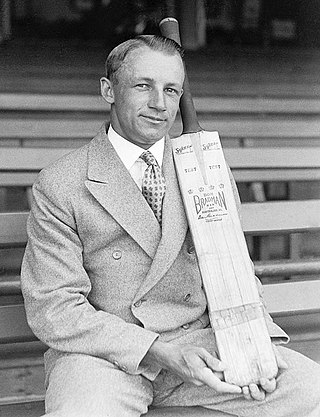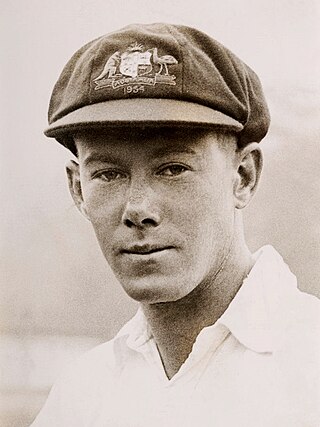Related Research Articles

The Australia men's national cricket team represents Australia in men's international cricket. As the joint oldest team in Test cricket history, playing in the first ever Test match in 1877, the team also plays One-Day International (ODI) and Twenty20 International (T20I) cricket, participating in both the first ODI, against England in the 1970–71 season and the first T20I, against New Zealand in the 2004–05 season, winning both games. The team draws its players from teams playing in the Australian domestic competitions – the Sheffield Shield, the Australian domestic limited-overs cricket tournament and the Big Bash League. Australia are the current ICC World Test Championship and ICC Cricket World Cup champions. They are regarded as most successful cricket teams in the history of Cricket.

A partnership is a term used in cricket, that usually refers to the two batters and the runs they score together, including extras. Two batters bat in a partnership, although only one is a striker at any time. The partnership between two batsmen will come to an end when one of them is dismissed or retires, or the innings comes to a close, usually due to victory being achieved, a declaration, a time or over limit being reached, the match being abandoned. In exceptional cases, if one of the original batters are injured, a player may run between the wickets on behalf of the injured batter. However, any runs scored by the injured batter will be recorded as being in the partnership of the two original batters. A partnership may also refer to two bowlers bowling from each end of the wicket.

The Australian cricket team in England in 1948 is famous for being the only Test match side to play an entire tour of England without losing a match. This feat earned them the nickname of "The Invincibles", and they are regarded as one of the greatest cricket teams of all time. According to the Australian federal government, the team "is one of Australia's most cherished sporting legends". The team was captained by Don Bradman, who was making his fourth and final tour of England.

Arthur Robert Morris was an Australian cricketer who played 46 Test matches between 1946 and 1955. An opener, Morris is regarded as one of Australia's greatest left-handed batsmen. He is best known for his key role in Don Bradman's Invincibles side, which made an undefeated tour of England in 1948. He was the leading scorer in the Tests on the tour, with three centuries. His efforts in the Fourth Test at Headingley helped Australia to reach a world record victory target of 404 on the final day. Morris was named in the Australian Cricket Board's Team of the Century in 2000 and was inducted into the Australian Cricket Hall of Fame in 2001.
In cricket, the term carry the bat refers to an opening batsman who is not dismissed when the team innings is closed.
The Australian cricket team toured India from February to April 2001 for a three-Test series and a five-match ODI series. The series is considered one of India's finest, as they secured victory against Australia in the Test series, in the process breaking Australia's 16-match win streak in Tests, and being the third side to win a Test match after being asked to follow-on during the match in Kolkata. The Kolkata match has been widely regarded as one of the greatest matches in the sport's history.
A pair in cricket refers to when a batsman is dismissed for a duck in both innings. It is called a 'king pair' if the batsman gets out for a golden duck in both innings.

The 1948 Ashes series was that year's edition of the long-standing cricket rivalry between England and Australia. Starting on 10 June 1948, England and Australia played five Tests. Australia had not lost a Test since the Second World War and were strong favourites. Their captain Don Bradman had publicly expressed his ambition of going through the tour without defeat, and Australia won 10 of their 12 lead-up matches, eight by an innings. The England team, however, had several notable players themselves, including Len Hutton, Denis Compton and Alec Bedser. Nevertheless, the final result was a 4–0 series win for Australia, with the Third Test being drawn. They thus retained The Ashes. The Australians remained undefeated for their entire tour of England, earning them the sobriquet of The Invincibles.

Keith Miller was a member of Donald Bradman's famous Australian cricket team, which toured England in 1948 and went undefeated in its 34 matches. This unprecedented feat by a Test side touring England earned the Australians the sobriquet "The Invincibles". Miller was an all-rounder: a right-arm opening fast bowler and a right-handed middle-order batsman. With Ray Lindwall, he formed Australia's first-choice opening attack, a combination regarded as one of the best of all time. Miller was also a skillful slip fielder, regarded by his captain as the best in the world.

The Fifth Test of the 1948 Ashes series, held at The Oval in London, was the final Test in that cricket series between Australia and England. The match took place on 14–18 August, with a rest day on 15 August. Australia won the match by an innings and 149 runs to complete a 4–0 series win. It was the last Test in the career of Australian captain Donald Bradman, generally regarded as the best batsman in the history of the sport. Going into the match, if Australia batted only once, Bradman needed only four runs from his final innings to have a Test batting average of exactly 100, but he failed to score, bowled second ball for a duck by leg spinner Eric Hollies.
Ray Lindwall was a key member of Donald Bradman's famous Australian cricket team, which toured England in 1948. The Australians went undefeated in their 34 matches; this unprecedented feat by a Test side touring England earned them the sobriquet The Invincibles.
Arthur Morris was a key member of Donald Bradman's famous Australian cricket team, which toured England in 1948. The Australians went undefeated in their 34 matches; this unprecedented feat by a Test side touring England earned them the sobriquet The Invincibles.
The Second Test of the 1948 Ashes series was one of five Tests in The Ashes cricket series between Australia and England. The match was played at Lord's in London from 24 to 29 June, with a rest day on 27 June 1948. Australia won the match by 409 runs to take a 2–0 lead, meaning that England would need to win the remaining three matches to regain The Ashes.

The First Test of the 1948 Ashes series was one of five Tests in The Ashes cricket series between Australia and England. The match was played at Trent Bridge in Nottingham from 10 to 15 June with a rest day on 13 June 1948. Australia won the match by eight wickets to take a 1–0 series lead.
Lindsay Hassett was the vice-captain and one of three on-tour selectors for Don Bradman's famous Australian cricket team, which toured England in 1948. The Australians went undefeated in their 34 matches; this unprecedented feat by a Test side touring England earned them the sobriquet The Invincibles, and resulted in them being regarded as one of the greatest teams of all time. A right-handed batsman, Hassett played in all five Tests; he was a middle-order batsman in all but the Fourth Test, when he stood in as an opener due to an injury to Sid Barnes.

Bill Brown was a member of Donald Bradman's famous Australian cricket team, which toured England in 1948. Bradman's men went through their 34 matches without defeat; this unprecedented feat by a Test side touring England earned them the sobriquet The Invincibles.

Sid Barnes was a key member of Donald Bradman's famous Australian cricket team, which toured England in 1948. The team went undefeated in their 34 matches; this unprecedented feat by a Test side touring England earned them the sobriquet The Invincibles. A right-handed opening batsman, Barnes was part of Bradman's first-choice team and played in four of the five Tests—he missed one match due to injury—partnering the left-handed Arthur Morris.

Sam Loxton was a member of Donald Bradman's famous Australian cricket team, which toured England in 1948. Bradman's men went undefeated in their 34 matches; this unprecedented feat by a Test side touring England earned them the sobriquet The Invincibles.
References
- ↑ "The origins of cricket jargon". BBC. Retrieved 17 November 2018.
- ↑ LONDON from THE DAILY TIMES CORRESPONDENT, 25 July 1866 can be viewed at Paper's past
- ↑ "duck". AskOxford.com. Archived from the original on 23 September 2004. Retrieved 29 March 2009.
- ↑ "Australia v England in 1876/77". CricketArchive. Retrieved 22 May 2007.
- ↑ "Records | Test matches | Batting records | Most ducks in career | ESPNcricinfo.com". Cricinfo. Retrieved 10 July 2019.
- ↑ "Most Ducks in First-Class Cricket". CricketArchive. Archived from the original on 3 March 2016. Retrieved 22 May 2007.
- ↑ "Don Bradman". CricketArchive. Retrieved 22 May 2007.
- ↑ Frindall, Bill (2009). Ask Bearders. BBC Books. pp. 80–81. ISBN 978-1-84607-880-4.
- ↑ Morris, Steven (7 September 2011). "Ducks all round: the cricket team that was all out for nought". The Guardian. ISSN 0261-3077 . Retrieved 13 February 2016.
- ↑ "Cricket team bowled out for zero in Kent indoor game". BBC Sport. 11 February 2016. Retrieved 13 February 2016.
- ↑ "Records | Combined Test, ODI and T20I records | Batting records | Most ducks in career | ESPNcricinfo.com". Cricinfo. Retrieved 10 July 2019.
- 1 2 "Cricket explained". Cricinfo . Retrieved 22 May 2007.
- ↑ "The origins of cricket jargon". BBC . Retrieved 14 October 2023.
- ↑ Victorian Cricket Association Umpires and Scorers Association Association Newsletter, Vol. 15 No. 5, 2008–2009 season, p11
- ↑ "cricket.com.au Twenty20 Match Commentary". Archived from the original on 20 January 2009. Retrieved 17 January 2009.
- ↑ "Diamond duck places Katich in select Ashes club". The Sydney Morning Herald. 4 December 2010.
- ↑ "Middlesex facing innings defeat at Lord's". Middlesex County Cricket Club. 22 June 2006. Archived from the original on 5 February 2012. Retrieved 8 September 2013.
- ↑ Blofeld, Henry (18 August 2003). "CRICKET: Smith has the class and character to revive England". The Independent . Archived from the original on 8 September 2013. Retrieved 8 September 2013– via Find Articles.
Conversely, Graham Gooch made a pair of spectacles in his first Test, against Australia.
- 1 2 Fleming, Stephen (30 May 2001). "The sort of Audi that nobody wants". ESPNcricinfo. Retrieved 20 November 2021.
- 1 2 3 Lynch, Steven (28 May 2012). "Which end of the bat do I hold? Batsmen who went through spells of wretched form". ESPNcricinfo. Retrieved 20 November 2021.
- 1 2 Martin, Ali (16 January 2021). "Joe Root's inspired 228 keeps England in command before rally from Sri Lanka". The Guardian. Retrieved 20 November 2021.
- ↑ Lemon, Geoff (26 June 2023). "Alyssa Healy plays pivotal role to steer Australia back on path to victory". The Guardian . Retrieved 26 June 2023.
- ↑ "5 Batsmen with most consecutive ducks in Test cricket". Sports.info. Retrieved 20 November 2021.